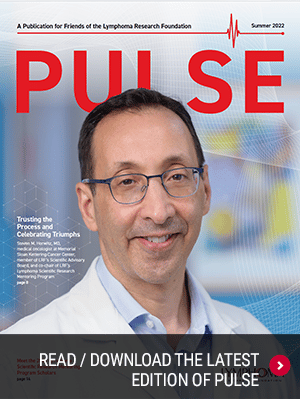LRF Urges CDC to Prioritize Blood Cancer Patients for COVID-19 Vaccine
VISIT THE COVID-19 LEARNING CENTER FOR MORE UPDATES AND HELPFUL RESOURCES

The well-being of the lymphoma community is the top priority of the Lymphoma Research Foundation (LRF). People with cancer, who are in active cancer treatment or have been previously been treated for cancer, older patients, and people with other serious chronic medical conditions, may be at higher risk should they contract the coronavirus. In an effort to help lymphoma patients receive the care that they need, the LRF joined the blood cancer organizations CLL Society, Leukemia & Lymphoma Society (LLS), and International Waldenstroms Macroglobulinemia Foundation (IWMF) to urge the Advisory Committee on Immunization Practices at the Centers for Disease Control and Prevention to prioritize the COVID-19 vaccination for blood cancer patients. Read the full letter below.
Dear Advisory Committee Members,
We write on behalf of patients, families, and caregivers affected by blood cancers to ensure your awareness of the evolving data regarding the impact of COVID-19 on this vulnerable patient population. As the Committee continues its critical work, we urge that consideration be given to the importance of ensuring swift receipt of the COVID-19 vaccine among blood cancer patients.
Collectively, our organizations are dedicated to the needs of the more than 1.5 million people in the U.S. who are either living with or are in remission from, leukemia, lymphoma, or myeloma. Over 150,000 Americans are diagnosed with blood cancers annually, accounting for nearly 10 percent of all new cancer diagnoses in the United States. Our organizations fund lifesaving blood cancer research, provide free information and support services, and advocate for public policies that address the needs of patients with blood cancer.
A recent peer-reviewed meta-analysis of 3,240 adult patients with hematologic malignancies published in December of 2020, showed the mortality rate was 34% [1] (mortality rates in the general population comparatively are 1.4% at age 65, 4.6% at age 75, and 15% at age 85) [2].
Additionally, newly emerging evidence indicates there are increased morbidity and mortality risks to blood cancer patients when they contract the virus. In comparison to the general population, they have:
- Higher mortality [1,2,3,4]
- Longer infections and more severe symptoms [5, 6]
- Sustained period of viral shedding [7, 8]
Another important concern is that the impaired immunity of those with hematologic malignancies leads to long-term harboring of the SARS-CoV-2 virus, which can accelerate the incidence of viral mutations and places everyone at risk. [4]
We encourage the committee to review this evidence9-18 and to stay abreast of additional data illuminating the impact of the virus on this highly vulnerable population as you continue to formulate recommendations guiding vaccine prioritization. We also offer our collective resources and expertise to support you in this important work.
Thank you for your swift attention to this matter. We recognize the significant challenges facing the Committee, and we are extremely grateful for your thoughtful efforts to guide the effective and equitable distribution of these important vaccinations.
Sincerely,
Brian Koffman MDCM (retired) MS Ed
Executive Vice President and Chief Medical Officer CLL Society, Inc.
Gwen Nichols, MD
Executive Vice President and Chief Medical Officer
Leukemia & Lymphoma Society
Meghan Gutierrez
Chief Executive Officer
Lymphoma Research Foundation
Pete DeNardis
Board of Trustees Chair
International Waldenstrom’s Macroglobulinemia Foundation
References:
- Vijenthira, A., et al.2020. Outcomes of patients with hematologic malignancies and COVID-19: A systemic review and meta-analysis of 3377 patients. Blood. 136: 2882 – 2892.
https://www.sciencedirect.com/science/article/pii/S2666364320301922 - Levin, A., et al., 2020. Assessing the Age Specificity of Infection Fatality Rates for COVID-19: Systematic Review, Meta-Analysis, and Public Policy Implications. European Journal of Epidemiology. https://doi.org/10.1101/2020.07.23.20160895
- Mehta, V., et al., 2020. Case fatality rate of cancer patients with COVID-19 in a New York hospital system. Cancer Disc. 10: 935-941. https://pubmed.ncbi.nlm.nih.gov/32357994/
- Lee, LYW., et al., 2020. COVID-19 prevalence and mortality in patients with cancer and the effect of primary tumor subtypes and patient demographics: A prospective study. Lance Oncol. 21: 1309-1316. https://doi.org/10.1016/S1470-2045(20)30442-3
- Kemp, SA., et al., 2020. Neutralizing antibodies drive spike mediated SARS-CoV-2 evasion. Preprint. https://www.medrxiv.org/content/10.1101/2020.12.05.20241927v1
- Thakkar, A., et al., 2021. Patterns of seroconversion for SARS-CoV-2-igG in patients with malignant disease and association with anti-cancer therapy. Research Square https://doi.org/10.21203/rs.3.rs-127470/v1
- Avdillo, T., et al., 2020. Shedding of viable SARS-CoV-2 after immunosuppressive therapy for cancer. N Engl J Med. 383: 2586-2588. https://www.nejm.org/doi/pdf/10.1056/NEJMc2031670
- Abdul-Jawad, S., 2021. Acute immune signatures and their legacies in severe acute respiratory syndrome coronavirus-2 infected cancer patients. Cancer Cell. Preprint. https://doi.org/10.1016/j.ccell.2021.01.001
- Avanzato, VA., 2020. Case Study: Prolonged infectious SARS-CoV-2 shedding from an asymptomatic immunocompromised cancer patient. Cell. 183: 1901-1912. https://doi.org/10.1016/j.cell.2020.10.049
- Bazykin, GA., et al. 2021. Emergence of Y453F and delta69-70V mutations in a lymphoma patient with long-term COVID-19. Virological.org. https://virological.org/t/emergence-of-y453f-and-69-70hv-mutations-in-a-lymphoma-patient-with-long-term-covid-19/580
- Branagan, et al., 2017. Clinical and serologic responses after a two-dose series of high-dose influenza vaccine in plasma cell disorders: a prospective, single-arm trial. Clin Lymph Myeloma Leuk. 17: 296-304. https://pubmed.ncbi.nlm.nih.gov/28343904/
- Choi, B., et al. 2020. Persistence and evolution of SARS-CoV-2 in an immunocompromised host. N Engl J Med. 383: 2291-2293. https://www.nejm.org/doi/10.1056/NEJMc2031364
- Garcia-Suarez, J., 2020. Impact of hematologic malignancy and type of cancer on COVID-19 severity and mortality: lessons from a large population-based registry study. J Hematol Oncol. 13:133-145. https://doi.org/10.1186/s13045-020-00970-7
- Fillmore, NR., et al. 2020. Prevalence and outcome of COVID-19 infections in cancer patients: A national Veterans Affairs study. J Natl Cancer Inst. https://pubmed.ncbi.nlm.nih.gov/33031532/
- Hensley, MK., et al.2021. Intractable SARS-CoV-2 infection in a CAR-T-cell therapy recipient. MedRxiv. Link to draft provided by authors: https://osf.io/bmhse/
- McCarthy, KR., 2021. Natural deletions in the SARS-CoV-2 spike glycoprotein drive antibody escape. BioRxiv. https://www.biorxiv.org/content/10.1101/2020.11.19.389916v1
- Wang, Q., et al. 2020. Analyses of risk, racial disparity, and outcomes among US patients with cancer and COVID-19 infection. JAMA Onc. https://jamanetwork.com/journals/jamaoncology/fullarticle/2773500
- Wood, WA., et al. 2020. Outcomes of patients with hematologic malignances and COVID-19 infections: a report from the ASH Research Collaborative Data Hub. ASH 2020 abstract # 215. https://ash.confex.com/ash/2020/webprogram/Paper141327.html



